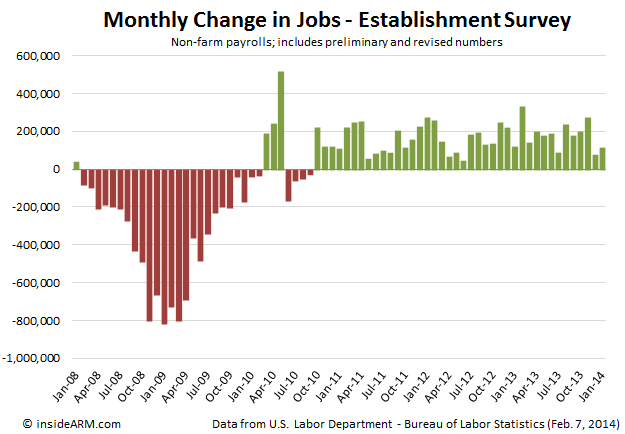The U.S. Labor Department Friday issued an employment report for January that showed job growth far below expectations, but a dip in the official unemployment rate to 6.6 percent from 6.7 percent in December. Investors seemed to applaud the report, in part, sending stocks higher in Friday trading. Why?
In a survey of establishments that employ people, non-farm payrolls added just 113,000 jobs in January, far below expectations of around 190,000 and also lower than the private sector ADP report earlier in the week of 175,000. The discrepancy between the ADP report and the Labor report can be partially explained by a net reduction in government jobs in January leading to a 142,000 private sector increase, according to Labor.
But the official unemployment rate is derived from a separate survey of U.S. households. That survey yielded a net gain of more than 600,000 jobs in the month, the largest increase in more than three years. Also against trend: households reported an increase in the labor pool of nearly 500,000. The sharp increase in the labor participation rate actually prevented the unemployment rate from falling even more than it did in January.
The divide between the employer survey and household survey has been growing in recent months. Over the past three months, the household survey says employment has increased by an average of 580,000 per month. The establishment survey says payrolls have increased by just 154,000 per month.
Economists put more trust the establishment survey; the sample size is larger and the results are less volatile. The household survey is much broader because it includes self-employed workers, farm workers, and people working in family businesses.
But there was still some good news in the January establishment survey under the surface. For starters, the initially-reported numbers from November and December were revised upward by a total of 34,000 jobs. Also, for the first time since 2009, job growth in construction (+48,000) and manufacturing (+21,000) outpaced gains in professional services (+36,000) and healthcare (flat).
On the household survey side, the labor participation rate increased to 63.0 percent in January from 62.8 percent in December. This sent the U-6 alternative measure of unemployment, often called the “real” unemployment rate, down to 12.7 percent, the lowest reading since November 2008 and down from 14.4 percent from just a year ago. The U-6 factors in those who have given up looking for work or are employed part time but want full time jobs.
For the ARM industry, the main takeaway is that job growth is occurring. It’s still maddeningly slow, but at the very least, more people are reporting themselves as employed, even if businesses disagree.




![[Image by creator from ]](/media/images/patrick-lunsford.2e16d0ba.fill-500x500.jpg)

![the word regulation in a stylized dictionary [Image by creator from ]](/media/images/Credit_Report_Disputes.max-80x80.png)
![Cover image for New Agent Onboarding Manuals resource [Image by creator from insideARM]](/media/images/New_Agent_Onboarding_Manuals.max-80x80_3iYA1XV.png)


![[Image by creator from ]](/media/images/New_site_WPWebinar_covers_800_x_800_px.max-80x80.png)
![[Image by creator from ]](/media/images/Finvi_Tech_Trends_Whitepaper.max-80x80.png)
![[Image by creator from ]](/media/images/Collections_Staffing_Full_Cover_Thumbnail.max-80x80.jpg)
![Report cover reads One Conversation Multiple Channels AI-powered Multichannel Outreach from Skit.ai [Image by creator from ]](/media/images/Skit.ai_Landing_Page__Whitepaper_.max-80x80.png)
![Report cover reads Bad Debt Rising New ebook Finvi [Image by creator from ]](/media/images/Finvi_Bad_Debt_Rising_WP.max-80x80.png)
![Report cover reads Seizing the Opportunity in Uncertain Times: The Third-Party Collections Industry in 2023 by TransUnion, prepared by datos insights [Image by creator from ]](/media/images/TU_Survey_Report_12-23_Cover.max-80x80.png)
![Webinar graphic reads RA Compliance Corner - Managing the Mental Strain of Compliance 12-4-24 2pm ET [Image by creator from ]](/media/images/12.4.24_RA_Webinar_Landing_Page.max-80x80.png)